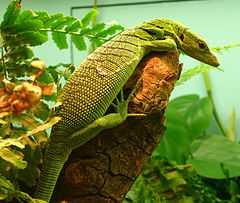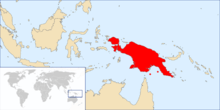Emerald tree monitor
| Emerald tree monitor[1] | |
|---|---|
 | |
| Conservation status | |
| Scientific classification | |
| Kingdom: | Animalia |
| Phylum: | Chordata |
| Class: | Sauropsida |
| Order: | Squamata |
| Suborder: | Lacertilia |
| Family: | Varanidae |
| Genus: | Varanus |
| Subgenus: | Euprepiosaurus |
| Species: | V. prasinus |
| Binomial name | |
| Varanus prasinus Schlegel, 1839 | |
 | |
| Distribution of the emerald tree monitor, shown in red. | |
The emerald tree monitor (Varanus prasinus) or green tree monitor, is a small to medium-sized arboreal monitor lizard. It is known for its unusual coloration, which consists of shades from green to turquoise, topped with dark, transverse dorsal banding. This coloration helps camouflage it in its arboreal habitat.[2] Its colour also makes the emerald tree monitor highly exploited to the pet trade and kept in zoos alike.[3]
Taxonomy
V. prasinus was first described as Monitor viridis by John Edward Gray in 1831; however, Gray's original holotype (RMNH 4812 in the National Natural History Museum in Leiden) was lost and the species was redescribed by Schlegel eight years later as V. prasinus using the found specimen.[4] The generic name Varanus is derived from the Arabic word waral (ورل), which translates to English as "monitor".[5] Its specific name, prasinus, is Latin for the color green.
V. prasinus is a member of the Euprepiosaurus subgenus. It is closely related to several other arboreal species; when combined, these are often referred to as the V. prasinus species group. In addition to V. prasinus, this species group, whose members are all allopatric, includes V. beccarii (Aru Islands), V. boehmei (Waigeo Island), V. bogerti (D'Entrecasteaux Archipelago), V. keithhornei (Cape York Peninsula), V. kordensis (Biak Island), V. macraei (Batanta Island), V. reisingeri (Misool Island) and V. telenesetes (Rossel Island).[6][7]
Evolutionary development
The evolutionary development of V. prasinus started with the Varanus genus, which originated in Asia about 40 million years ago and migrated to Australia and the Indonesian archipelago around 15 million years ago.[8]
Distribution
Emerald tree monitors and their close relatives can be found in New Guinea, as well as several adjacent islands,[9] and the northern Torres Strait Islands.[10]
References
- ↑ "Varanus prasinus". Integrated Taxonomic Information System. Retrieved 28 August 2008.
- ↑ Wilson, Don W.; Burnie, David (2001). Animal. London: DK. p. 422. ISBN 978-0-7894-7764-4.
- ↑ Bartlett, Patricia Pope; Bartlett, Richard D. (1996). Monitors, Tegus, and Related Lizards: Everything About Selection, Care, Nutrition, Diseases, Breeding, and Behavior. Woodbury, N.Y: Barron's Educational Series. p. 63. ISBN 978-0-8120-9696-5.
- ↑ Bennett, D. (1995). A Little Book of Monitor Lizards. Aberdeen, UK: Viper Press.
- ↑
- ↑ Jacobs, H. J. (2003). A further new emerald tree monitor lizard of the Varanus prasinus species group from Waigeo, West Irian (Squamata: Sauria: Varanidae). Salamandra 39(2): 65-74
- ↑ Ziegler, T., A. Schmitz, A. Koch and W. Böhme (2007). A review of the subgenus Euprepiosaurus of Varanus (Squamata: Varanidae): morphological and molecular phylogeny, distribution and zoogeography, with an identification key for the members of the V. indicus and the V. prasinus species groups. Zootaxa 1472: 1-28
- ↑ Ciofi, Claudio. "The Komodo Dragon". Scientific American. Retrieved 2006-12-21.
- ↑ Pianka, Eric R. (2006). Lizards: Windows to the Evolution of Diversity. Berkeley: University of California Press. p. 247. ISBN 978-0-520-24847-2.
- ↑ Cogger, H. G. (2000).
Description
The emerald tree monitor is about 75–100 cm (30–39 in) long with a slender body that helps it support itself on narrow branches. It uses its prehensile tail and long claws to grip branches.<ref name="animal"/><ref name="Cogger">{{Cite book| last = Cogger | first = Harold |authorlink = Harold Cogger | last2 = Zweifel | first2 = Richard | title = Reptiles & Amphibians | publisher = Weldon Owen | location = [[Sydney]] |year = 1992 | isbn = 978-0-8317-2786-4}}</ref><ref name="Greene"/> Unlike other varanids, this monitor defends its tail rather than lashing with it for defense when threatened.<ref name="Sprackland">{{Cite book|author=Robert George Sprackland |title=Giant lizards |publisher=T.F.H. Publications |location=Neptune, NJ |year=1992 |pages=137–142 |isbn=978-0-86622-634-9 }}</ref> The soles of the feet of the emerald tree monitor have enlarged scales which aid the lizard when climbing.<ref name = "Greene"/> When threatened, the emerald tree monitor will flee through vegetation or bite if cornered. It is one of the few social monitors, living in small groups made up of a dominant male, several females, and a few other males and juveniles.<ref name="animal"/> Emerald tree monitors at the Bristol Zoo
Emerald tree monitors at the Bristol ZooDiet
The emerald tree monitor's diet consists of large tree-dwelling arthropods, such as katydids, stick insects, cockroaches, beetles, centipedes, spiders, crabs, birds, and small mammals. Before swallowing stick insects, the lizards tear off the legs.<ref name=VLOTW/> Captive specimens tear off the limbs of rodents prior to eating them; as a result, they are capable of swallowing mammals of a considerable size: A 135-g lizard was documented as eating a 40-g rodent, almost one-third its size. Paleontologist and Temple University professor Michael Balsai has observed V. prasinus eating fruit (bananas) in captivity as has herpetologist and author Robert G. Sprackland.<ref>{{cite book | last =Balsai | first = Michael| authorlink = | title = The General Care and Maintenance of Popular Monitors and Tegus| publisher = BowTie| year = 1997 | location = | page = 6| isbn =978-1-882770-39-7 }}</ref><ref name="Sprackland"/>Reproduction
Clutches consist of up to five eggs, each weighing 10.5–11.5 g (0.37–0.41 oz) and measuring about 2 by 4.5 cm (0.79 by 1.77 in). As many as three clutches are laid throughout the year; clutches have been laid by captives in January, March, April, November, and December. The female emerald tree monitor lays her eggs in arboreal termite nests.<ref name = "Greene"/> The eggs hatch between 160 and 190 days later, typically from June to November, after which the young eat the termites and the termite's eggs within minutes of hatching.<ref name = "Greene">{{Cite book| last = Greene | first = Harry W. | title = Diet and Arboreality in the Emerald Monitor, Varanus Prasinus, With Comments on the Study of Adaptation | publisher = Field Museum of Natural History | year = 1986 | oclc=14915452 }}</ref> Sexual maturity is reached in about one year.<ref name="Varanoid">King, Ruth Allen; Pianka, Eric R.; King, Dennis (2004). Varanoid Lizards of the World. Bloomington: Indiana University Press. pp. 225–229. ISBN 978-0-253-34366-6.
External links
| ||||||||||||||||||||||||||||||||||||||||||||||||||||||||||||||||||